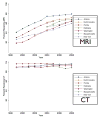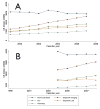Wide variation and rising utilization of stroke magnetic resonance imaging: data from 11 states
- PMID: 22367989
- PMCID: PMC3297973
- DOI: 10.1002/ana.22698
Wide variation and rising utilization of stroke magnetic resonance imaging: data from 11 states
Abstract
Objective: Neuroimaging is an essential component of the acute stroke evaluation. Magnetic resonance imaging (MRI) is more accurate than computed tomography (CT) for the diagnosis of stroke, but is more costly and time-consuming. We sought to describe changes in MRI utilization from 1999 to 2008.
Methods: We performed a serial cross-sectional study with time trends of neuroimaging in patients with a primary International Classification of Diseases, 9th Edition, Clinical Modification discharge diagnosis of stroke admitted through the emergency department in the State Inpatient Databases from 10 states. MRI utilization was measured by Healthcare Cost and Utilization Project criteria. Data were included for states from 1999 to 2008 where MRI utilization could be identified.
Results: A total of 624,842 patients were hospitalized for stroke in the period of interest. MRI utilization increased in all states. Overall, MRI absolute utilization increased 38%, and relative utilization increased 235% (28% of strokes in 1999 to 66% in 2008). Over the same interval, CT utilization changed little (92% in 1999 to 95% in 2008). MRI use varied widely by state. In 2008, MRI utilization ranged from a low of 55% of strokes in Oregon to a high of 79% in Arizona. Diagnostic imaging was the fastest growing component of total hospital costs (213% increase from 1999 to 2007).
Interpretation: MRI utilization during stroke hospitalization increased substantially, with wide geographic variation. Rather than replacing CT, MRI is supplementing it. Consequently, neuroimaging has been the fastest growing component of hospitalization cost in stroke. Recent neuroimaging practices in stroke are not standardized and may represent an opportunity to improve the efficiency of stroke care.
Copyright © 2012 American Neurological Association.
Figures



Comment in
-
Modern care for neurological problems must address waste.Ann Neurol. 2012 Feb;71(2):A5-6. doi: 10.1002/ana.23539. Ann Neurol. 2012. PMID: 22368006 No abstract available.
Similar articles
-
Hospital-based study of the care and cost of acute ischemic stroke in Japan.Stroke. 2003 Mar;34(3):718-24. doi: 10.1161/01.STR.0000056171.55342.FF. Epub 2003 Feb 13. Stroke. 2003. PMID: 12624297
-
National Imaging Trends in Pediatric Traumatic Brain Injury and Hydrocephalus.World Neurosurg. 2020 Jul;139:e399-e405. doi: 10.1016/j.wneu.2020.04.014. Epub 2020 Apr 16. World Neurosurg. 2020. PMID: 32305606
-
National trends in advanced outpatient diagnostic imaging utilization: an analysis of the medical expenditure panel survey, 2000-2009.BMC Med Imaging. 2013 Nov 26;13:40. doi: 10.1186/1471-2342-13-40. BMC Med Imaging. 2013. PMID: 24279724 Free PMC article.
-
What is the best imaging strategy for acute stroke?Health Technol Assess. 2004 Jan;8(1):iii, ix-x, 1-180. doi: 10.3310/hta8010. Health Technol Assess. 2004. PMID: 14731377 Review.
-
The appropriate use of neuroimaging in the diagnostic work-up of dementia: an economic literature review and cost-effectiveness analysis.Ont Health Technol Assess Ser. 2014 Feb 1;14(2):1-67. eCollection 2014. Ont Health Technol Assess Ser. 2014. PMID: 24592297 Free PMC article. Review.
Cited by
-
Updated Trends, Disparities, and Clinical Impact of Neuroimaging Utilization in Ischemic Stroke in the Medicare Population: 2012 to 2019.J Am Coll Radiol. 2022 Jul;19(7):854-865. doi: 10.1016/j.jacr.2022.03.008. Epub 2022 Apr 25. J Am Coll Radiol. 2022. PMID: 35483436 Free PMC article.
-
The association between advanced diagnostic imaging and ED length of stay.Am J Emerg Med. 2014 Oct;32(10):1253-8. doi: 10.1016/j.ajem.2014.07.038. Epub 2014 Aug 7. Am J Emerg Med. 2014. PMID: 25176565 Free PMC article.
-
The Cinderellas of the scanner: Magnetic resonance imaging 'pre-scan' and 'post-scan' times: Their determinants and impact on patient throughput.SA J Radiol. 2020 Dec 1;24(1):1946. doi: 10.4102/sajr.v24i1.1946. eCollection 2020. SA J Radiol. 2020. PMID: 33354368 Free PMC article.
-
Cost-Effectiveness of Advanced Neuroimaging for Transient and Minor Neurological Events in the Emergency Department.J Am Heart Assoc. 2021 Jun 15;10(12):e019001. doi: 10.1161/JAHA.120.019001. Epub 2021 May 31. J Am Heart Assoc. 2021. PMID: 34056914 Free PMC article.
-
Stroke Imaging: Quantity, But is There Quality?Med Care. 2016 May;54(5):423-5. doi: 10.1097/MLR.0000000000000538. Med Care. 2016. PMID: 27075899 Free PMC article. No abstract available.
References
-
- Brazzelli M, Sandercock PA, Chappell FM, et al. Magnetic resonance imaging versus computed tomography for detection of acute vascular lesions in patients presenting with stroke symptoms. Cochrane Database Syst Rev. 2009 Jan;1(4):CD007424. - PubMed
-
- Barber PA, Darby DG, Desmond PM, et al. Identification of major ischemic change. Diffusion-weighted imaging versus computed tomography. Stroke; a journal of cerebral circulation. 1999 Oct 01;30(10):2059–65. - PubMed
-
- Fiebach JB, Schellinger PD, Jansen O, et al. CT and diffusion-weighted MR imaging in randomized order: diffusion-weighted imaging results in higher accuracy and lower interrater variability in the diagnosis of hyperacute ischemic stroke. Stroke; a journal of cerebral circulation. 2002 Sep 01;33(9):2206–10. - PubMed
-
- González RG, Schaefer PW, Buonanno FS, et al. Diffusion-weighted MR imaging: diagnostic accuracy in patients imaged within 6 hours of stroke symptom onset. Radiology. 1999;210(1):155–62. - PubMed

